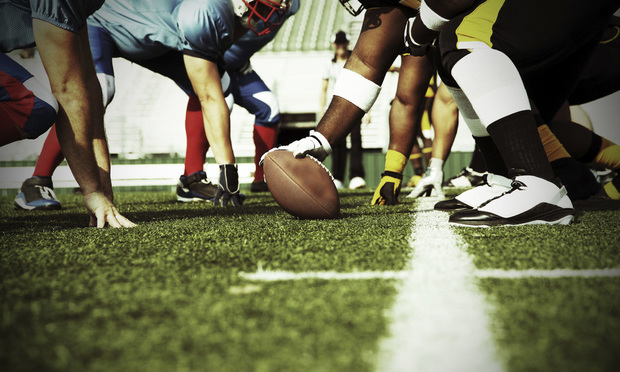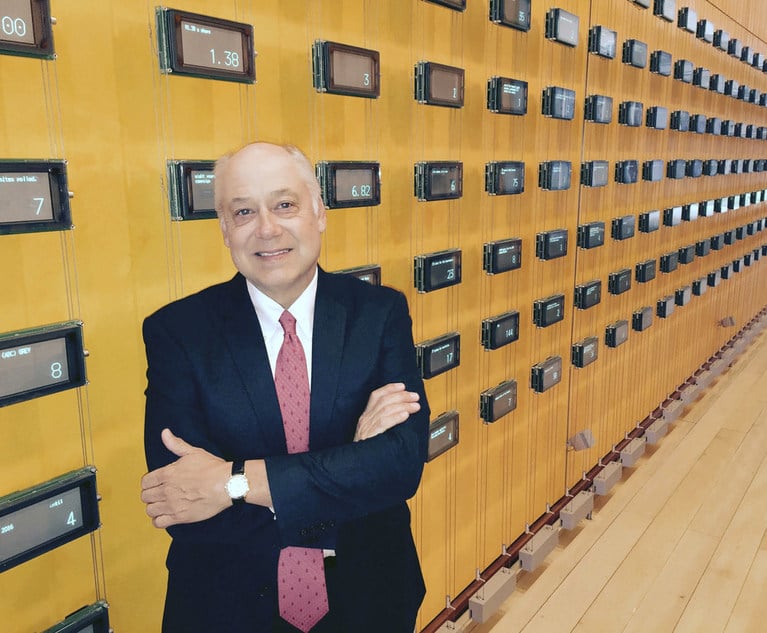Can Concussion Litigation Make the Leap to Products Liability?
Sports-related concussion litigation has been expanding across the country, with everything from the NFL and colleges to high schools and youth sports programs becoming defendants. But, even as the number of cases continues to climb, some see hurdles if attorneys want to push concussion litigation beyond basic negligence claims.
December 14, 2017 at 06:32 PM
5 minute read
 Photo: Fotolia
Photo: Fotolia Sports-related concussion litigation has been expanding across the country, with everything from the NFL and colleges to high schools and youth sports programs becoming defendants. But, even as the number of cases continues to climb, some see hurdles if attorneys want to push concussion litigation beyond basic negligence claims.
The most high-profile concussion litigation so far is the $1 billion class action settlement that the National Football League agreed to pay to cover injuries that former players sustained while playing professionally, but, the National Collegiate Athletic Association—which regulates intercollegiate sports—has been the subject of concussion lawsuits, as have the Pop Warner youth league, and numerous high schools and colleges across the country. Those cases are all focused on claims involving what the agencies and institutions knew or should have known about concussion risk, and whether their staff acted reasonably when working with players.
With little exception, concussion litigation has focused on these agencies and institutions, and some attorneys question whether concussion litigation can include products liability claims.
“There isn't anybody to my knowledge who can say, 'I can make a concussion-proof helmet,'” attorney Mark Granger of Granger Legal Consulting said. Granger is a member of the American Society for Testing and Materials and serves on its committee on sports, sports equipment and facilities. “Helmets do great things to reduce the risk of injury, and they do what they were designed to do: stop catastrophic brain injuries, cracked skulls and subdural hematomas.”
Montgomery McCracken Walker & Rhoads attorney Steven Pachman, who focuses on defending concussion lawsuits, said that the majority of concussion cases involve failure to warn claims.
“There really haven't been too many cases that I've seen in the product liability context, or certainly successful ones in the concussion arena,” he said. “It's pretty well-known now, through how publicized the concussion issue is, that helmets cannot prevent concussions.”
Kline & Specter attorney Thomas R. Kline agreed that the focus of concussion litigation will likely remain on the agencies and institutions overseeing the sporting events, but said that, given how fact-specific these cases are, attorneys will continue to evaluate each case for possible products liability claims, or any other ancillary claims, such as premises liability, or medical malpractice.
“I don't see it as a primary liability theory, but I certainly see it as being part of the many factors,” he said. ”There is a constellation of additional ancillary issues and avenues of investigation.”
Pachman said that, although he does not foresee products liability becoming the focus of concussion litigation, the types of concussion-related claims being brought is still expanding.
A decade ago, he said, not all schools had policies and protocols in place dealing with concussion. However, as the science around concussion detection improves and the public's awareness of the issue grows, the protocols are becoming more complex and schools are increasingly needing to update those policies to stay on top of the latest understanding of the injury. He noted that in 2010, most college sports teams only needed to have a concussion management plan on file, but seven years later those same schools are now required to submit new protocols each year to specialized safety committees and to do baseline neurocognitive testing on the athletes.
Whereas cases used to focus on a school's failure to have a policy in place, Pachman said, claims are now beginning to focus on whether the policy was properly followed, or if it is up to date.
“I see lawsuits continuing for some time to come largely because of the detailed requirements on schools and trainers that just weren't there a few years ago,” Pachman said.
Some of the biggest hurdles for plaintiffs is that many schools and state agencies that oversee sports programs are either immune under governmental immunity laws, or are subject to much less exposure than a private institution. Pachman and Granger also said that, with concussions becoming so prevalent, it is becoming increasingly difficult for injured players to claim they were unaware of the risks.
The U.S. Court of Appeals for the Third Circuit's recent decision in Mann v. Palmerton Area School District said some plaintiffs may be able to pursue claims stemming from a player's constitutional right to bodily integrity. That cause of action would allow plaintiffs to circumvent state-imposed immunity protections.
Pursuing claims against product designers and manufacturers is another way to avoid a limited recovery, and some cases are currently being litigated.
One high-profile case is underway in federal court. That litigation is aimed at the helmet maker Riddell, and it is an offshoot of the NFL settlement. Along with raising claims related to alleged negligence and concealment, the plaintiffs are contending that the helmets did not adequately protect against concussions.
Kline said he has seen some successful products liability claims stemming from concussion injuries, but Granger said strict liability cases are very difficult to make.
According to Granger, although scientists have nailed down the amount of direct force that can cause a player to sustain a concussion, the amount of rotational force a player can sustain before developing a concussion remains largely a mystery. The fact that the science is still in flux makes it unlikely that any judge would allow a products liability case to proceed against a helmet manufacturer, he said.
“Helmets were never designed with the idea that they were to prevent concussions,” Granger said.
This content has been archived. It is available through our partners, LexisNexis® and Bloomberg Law.
To view this content, please continue to their sites.
Not a Lexis Subscriber?
Subscribe Now
Not a Bloomberg Law Subscriber?
Subscribe Now
NOT FOR REPRINT
© 2025 ALM Global, LLC, All Rights Reserved. Request academic re-use from www.copyright.com. All other uses, submit a request to [email protected]. For more information visit Asset & Logo Licensing.
You Might Like
View All
Class Action Settlements Totaled $40B+ Three Years in a Row: 'We’re in a New Era'
5 minute read
AI's Place in Big Law Broadens, As Firms Embrace Fresh Uses of the Technology

Ballard Spahr Aims to Balance Hybrid Work With Relationship Building in Training New Associates
5 minute readTrending Stories
- 1Democracy in Focus: New York State Court of Appeals Year in Review
- 2In Vape Case, A Debate Over Forum Shopping
- 3SDNY Criminal Division Deputy Chief Returns to Debevoise
- 4Brownstein Adds Former Interior Secretary, Offering 'Strategic Counsel' During New Trump Term
- 5Tragedy on I-95: Florida Lawsuit Against Horizon Freight System Could Set New Precedent in Crash Cases
Who Got The Work
J. Brugh Lower of Gibbons has entered an appearance for industrial equipment supplier Devco Corporation in a pending trademark infringement lawsuit. The suit, accusing the defendant of selling knock-off Graco products, was filed Dec. 18 in New Jersey District Court by Rivkin Radler on behalf of Graco Inc. and Graco Minnesota. The case, assigned to U.S. District Judge Zahid N. Quraishi, is 3:24-cv-11294, Graco Inc. et al v. Devco Corporation.
Who Got The Work
Rebecca Maller-Stein and Kent A. Yalowitz of Arnold & Porter Kaye Scholer have entered their appearances for Hanaco Venture Capital and its executives, Lior Prosor and David Frankel, in a pending securities lawsuit. The action, filed on Dec. 24 in New York Southern District Court by Zell, Aron & Co. on behalf of Goldeneye Advisors, accuses the defendants of negligently and fraudulently managing the plaintiff's $1 million investment. The case, assigned to U.S. District Judge Vernon S. Broderick, is 1:24-cv-09918, Goldeneye Advisors, LLC v. Hanaco Venture Capital, Ltd. et al.
Who Got The Work
Attorneys from A&O Shearman has stepped in as defense counsel for Toronto-Dominion Bank and other defendants in a pending securities class action. The suit, filed Dec. 11 in New York Southern District Court by Bleichmar Fonti & Auld, accuses the defendants of concealing the bank's 'pervasive' deficiencies in regards to its compliance with the Bank Secrecy Act and the quality of its anti-money laundering controls. The case, assigned to U.S. District Judge Arun Subramanian, is 1:24-cv-09445, Gonzalez v. The Toronto-Dominion Bank et al.
Who Got The Work
Crown Castle International, a Pennsylvania company providing shared communications infrastructure, has turned to Luke D. Wolf of Gordon Rees Scully Mansukhani to fend off a pending breach-of-contract lawsuit. The court action, filed Nov. 25 in Michigan Eastern District Court by Hooper Hathaway PC on behalf of The Town Residences LLC, accuses Crown Castle of failing to transfer approximately $30,000 in utility payments from T-Mobile in breach of a roof-top lease and assignment agreement. The case, assigned to U.S. District Judge Susan K. Declercq, is 2:24-cv-13131, The Town Residences LLC v. T-Mobile US, Inc. et al.
Who Got The Work
Wilfred P. Coronato and Daniel M. Schwartz of McCarter & English have stepped in as defense counsel to Electrolux Home Products Inc. in a pending product liability lawsuit. The court action, filed Nov. 26 in New York Eastern District Court by Poulos Lopiccolo PC and Nagel Rice LLP on behalf of David Stern, alleges that the defendant's refrigerators’ drawers and shelving repeatedly break and fall apart within months after purchase. The case, assigned to U.S. District Judge Joan M. Azrack, is 2:24-cv-08204, Stern v. Electrolux Home Products, Inc.
Featured Firms
Law Offices of Gary Martin Hays & Associates, P.C.
(470) 294-1674
Law Offices of Mark E. Salomone
(857) 444-6468
Smith & Hassler
(713) 739-1250






